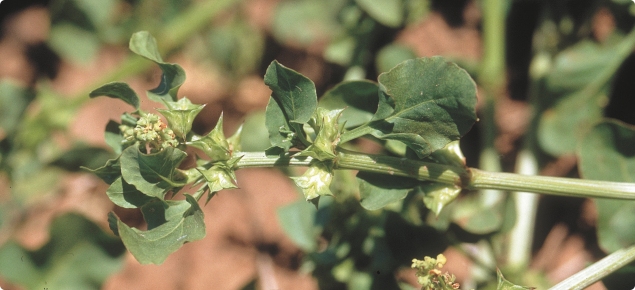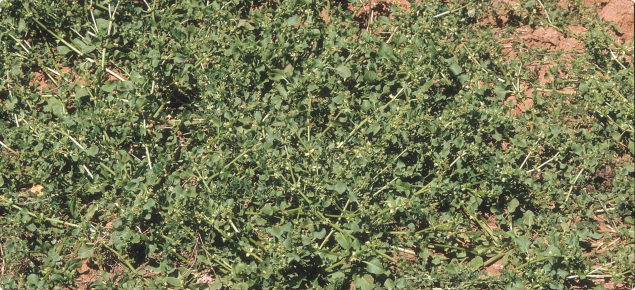Information about this pest can be found on the doublegee: declared pest page.
Login or set up a new account on DAFWAs online training site to access:
- a training course on how to identify doublegee and report it.
- training material that you can use to teach community groups how to identify doublegee.
Chemical requirements
When using any agricultural chemicals please ensure that you always follow instructions on the label and any permit. Users of agricultural chemical products must always strictly comply with the directions on the label and the conditions of any permit. To view permits or product labels go to the Australian Pesticides and Veterinary Medicines Authority website.
Control options
Chemical control options can be found below. For other methods of control please refer to the declared plant control handbook.
Chemical control options
| Recommended herbicides | Pre-sowing - wheat and triticale only:Chlorsulfuron, Logran® 714; Metsulfuron Post-sowing - wheat and barley:Metsulfuron In crops three to five leaf stage:Diuron + MCPA In crops five leaf stage to start of tillering:Dicamba (e.g. Banvel); Diuron + 2,4-DB Winter-spring:Glyphosate Pastures-when weeds actively growing:Diuron + 2,4-DB; Spinnaker® + Diuron Broadstrike® |
|---|
| Herbicide: Glyphosate (Group M) (various trade names: see APVMA link) | |
|---|---|
| Active ingredient | 360,450, 500g/L and 680, 700 and 840g/kg of glyphosate |
| Rate of dilution for spot spraying |
Adjust rates for other formulations of glyphosate |
| Rate of product/10L water | 50mL for 360g/L |
| Rate of product/ha |
Adjust rates for other formulations of glyphosate |
| Time of application | Winter-spring |
| Remarks | Glyphosate is non-selective: repeat each year until dormant seed in soil is exhausted |
| Herbicide: Chlorsulfuron (Group B) (various trade names: see APVMA link) | |
|---|---|
| Active ingredient | 750g/kg chlorsulfuron |
| Rates of dilution for spot spraying | Not recommended |
| Rate of product/10L water | Not recommended |
| Rate of product/ha | 20g |
| Time of application | Wheat and triticale pre-sowing only |
| Remarks and other control methods |
|
| Herbicide: Metsulfuron (Group B) (various trade names: see APVMA link) | |
|---|---|
| Active ingredient | 600g/kg metsulfuron methyl |
| Rates of dilution for spot spraying | Not recommended |
| Rate of product/10L water | Not recommended |
| Rate of product/ha | 5g |
| Wetting agent dilution | As per label |
| Time of application | Post-sowing wheat and barley |
| Remarks |
|
| Herbicide: Triasulfuron (Group B) (various trade names: see APVMA link) | |
|---|---|
| Active ingredient | 714g/kg triasulfuron |
| Rate of product/ha | 30g |
| Time of application | Pre-sowing wheat only |
| Remarks and other control methods |
|
| Herbicide: Dicamba (Group I) (various trade names: see APVMA link) | |
|---|---|
| Active ingredient |
|
| Rates of dilution for spot spraying |
|
| Rate of product/10L water |
|
| Rate of product/ha |
|
| Time of application |
|
| Remarks and other control methods |
|
| Herbicide: Diuron (Group C) + MCPA or 2,4-D amine (Group I) | |
|---|---|
| Active ingredient | 500g/L diuron 900g/kg diuron + 500g/L MCPA amine or 500g/L 2,4-D amine |
| Rates of dilution for spot spraying | 200mL diuron or 100g diuron + 1000mL MCPA or 2,4-D amine in 100L water |
| Rate of product/ha |
|
| Time of application |
|
| Remarks and other control methods | Spray-graze pastures with 2,4-D amine when weeds six to eight weeks old |
| Herbicide: Diuron (Group C) + 2,4-DB (Group I) | |
|---|---|
| Active ingredient | 500g/L diuron + 400g/L 2,4-DB |
| Rate of product/ha | 250mL + 400mL |
| Time of application | Weeds with cotyledons and one to two leaves |
| Remarks and other control methods |
|
| Herbicide: Spinnaker® (Group B)+ Diuron (Group C) | |
|---|---|
| Active ingredient | 700g/kg imazethapyr + 500g/L diuron |
| Rate of product/ha | 50g + 150-300mL |
| Wetting agent | 2% liquid ammonium sulphate |
| Time of application | When weeds actively growing having up to four leaves |
| Remarks and other control methods |
|
| Herbicide: Broadstrike® (Group B) | |
|---|---|
| Active ingredient | 800g/kg flumetsulam |
| Rate of product/ha | 25g |
| Wetting agent dilution | Uptake® 500mL per 100L or wetting agents such as BS-1000 @ 100mL/100L |
| Remarks and other control methods |
|



